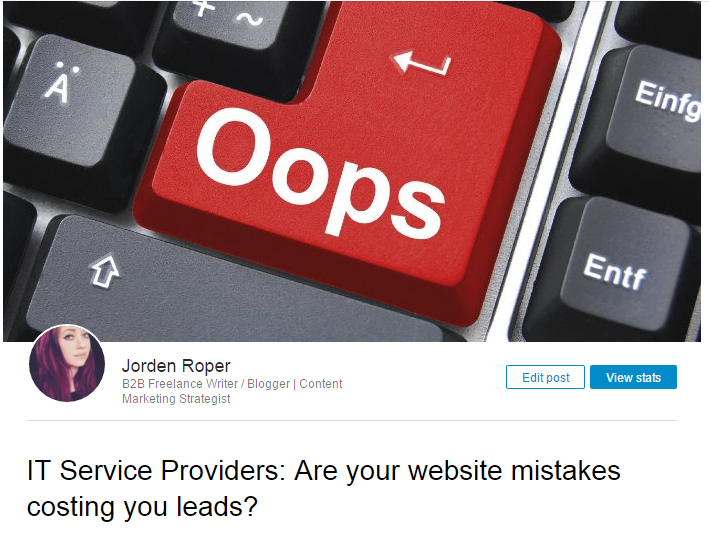April 2015 was a pretty tough month.
First, I found out that a mole on the back of my leg had turned into melanoma.
So I was freaking the fuck out about that pretty much 24/7.
And literally a few days later, I got fired (for the 3rd time in my life).
I mean, I think I was okay with it deep down because I hated my job (harsh but true) and had been planning my exit strategy for a while.
Still — suddenly having no source of income was difficult.
And to make matters worse, my husband’s work contract ended at the same time.
So there we were. No source of income.
I knew I had to take action. Fast.
I had been reading books and blogs about how to make it as a full-time freelance writer for a while, but I certainly didn’t feel “ready” to do it.
I did it anyway, though.
And just 4 months later, I had my first $5,000+ month.
(And I don’t say that to brag — I say it because I want you to know it’s possible to quickly make good money as a freelance writer, even if you’re a TOTAL BEGINNER.)
All of that income came from freelance writing work.
I think what really motivated me to work my ass off during that time was my melanoma diagnosis.
Thankfully, it didn’t end up being a serious thing because the melanoma was was only Stage 1, but still. When you’re told you have something on your body that might’ve killed you if it hadn’t been caught early, you really start to think about the way you’re living your life.
And I thought a lot about my career. I was tired of working with people who stole my ideas, tried to enforce pointless rules, and participated in office politics.
I also knew that, as a freelance writer, I didn’t want to settle for shitty content mills or work with rude, low-paying clients.
Life is too short for that bullshit.
I didn’t want to put up with any of it. So I built a freelance writer website and did everything I could to land high-paying clients.
And today, I want to share the methods I used with you. Because you shouldn’t have to put up with bullshit either.
(Keep in mind that I had no connections, no degree, and barely any writing samples when I started out. So if I can do it, then you can too!)
By the time you’re done reading this post, you’ll know how to get freelance writing clients that pay well (without joining gross websites like Upwork and Fiverr).
Let’s get started.
How to Get Freelance Writing Clients That Pay Well (Even If You’re a Newbie!)
1. Make LinkedIn your bitch.
Here’s a little secret: none of the clients I’ve landed from LinkedIn are clients I pitched.
I never even messaged them.
GASP. I know, right!?
Approach LinkedIn correctly, and clients will come to YOU.
Even if you’re a newbie.
Here’s what I did:
1. Filled out my LinkedIn profile the right way.
You need to use key words in your profile and your headline if you want clients to find you, okay?
Take a look at what I’m using on my profile right now:

If I didn’t include “B2B” (my niche) there, I can guarantee I wouldn’t get nearly as many clients from LinkedIn.
That’s because potential clients aren’t searching for a general “freelance writer” most of the time.
They’re searching for a specific kind of freelance writer. An expert.
So put your niche in your profile and headline.
And for the love of god, don’t write your summary like you’re a desperate job-seeker writing a resume summary!
Write it like you’re a badass business owner (because you are).
That means no barf-worthy jargon and meaningless adjectives. (Seriously. If you put the word “leverage” on your LinkedIn profile I might have to slap you.)
2. Added tons of my ideal clients as connections.
Since I targeted B2B/tech businesses, I added CEOs and marketing managers at those kinds of businesses.
It was an easy way to make myself visible to my target clients.
So start adding your target clients as connections once you’ve set up your profile (but don’t be spammy about it!).
Hint: you’ll find that more of your connection invitations are accepted if you send a personalized message with each of them.
3. Used LinkedIn Publisher to publish blog posts that targeted my ideal clients.
Think about what your ideal clients want to know in relation to what you’re selling.
For example, if you write blog posts for dental offices, you could publish a post on LinkedIn called “The ABCs of Content Marketing Success for Dental Offices.” If you write conversion copy for technology companies, you could write a post called “5 Easy Ways Tech Companies Can Convert More Website Visitors to Leads.”
Here’s an example of a post I published when I was targeting IT service providers:

Doing this (after you’ve added your ideal clients as connections) really helps you establish yourself as an expert within your niche.
And that, my friends, is how you start bringing in the big bucks.
It’s all about targeting a specific clientele and tailoring your ENTIRE marketing strategy to that clientele.
Now, what if you don’t want to use LinkedIn Publisher?
Well, you should still get active on LinkedIn.
Having a solid profile, making good connections, interacting with people there is more than enough to put you on an ideal client’s radar and make them want to hire you.
Side note: Want to learn exactly how to make $1,000 freelance writing in 45 days or less, even if you have NO experience? Join over 3,000 writers in my FREE class right here!
2. Send a ton of cold emails.
I landed $800 worth of clients in my first month as a full-time freelancer this way.
Scary? Yes.
Worth it? Also… yes.
The key to making cold emailing work for you is defining a niche and presenting yourself as an expert in that niche to the clients who need you the most.
You might be thinking:
Okay… but where do I find clients to send cold emails to?
Good question. You’ve got a few options:
Use Google. When I started out, I specialized in B2B/tech content, so I looked up all of the local IT service providers here in Dallas and emailed them with my pitch and a link to my site.
Use LinkedIn. But DON’T send a pitch as soon as you add a connection. The key to landing clients on social media is providing value and showing your expertise. You want the clients to come to you, and that won’t happen if you piss them off by spamming their InMail with something sales-y. Instead, interact with them a bit and then send them a message explaining how you can help their business.
Use LimeLeads. Most of my earliest clients came from Limeleads, which is basically a huge database of leads that can be narrowed down by industry. It’s awesome because it really helps you find businesses who need a writer with your expertise.
Remember – the key to a successful cold email is focusing on the client’s needs. So don’t drone on about your previous full-time jobs and how much you love writing. Clients don’t give a shit about that (sounds mean but it’s true!).
What they do care about is the ROI (return on investment) they’ll get when they hire you to write from them.
Figure out what kind of results they want, let them know that you can deliver those results (only if you actually can, of course), and you’ll be well on your way to cold emailing success.
3. Send some snail mail.
I’m totally serious, you guys. I was mailing businesses like crazy during my first month as a freelance writer.
And while it wasn’t my most efficient client-scoring method, it did land me a couple good clients (I still work with one of them!).
Here’s exactly what I did:
1. Ordered business cards from Moo.com and had a letterhead designed. This helped me come across as more professional, which was important. Remember, you’ll land more clients if you act like an expert business owner than you will if you act like a desperate job-seeker.
2. Looked up TONS of B2B/tech businesses (since that was my niche) and made a list of their marketing managers and addresses. I found the businesses by doing Google searches and found the marketing manager’s name on LinkedIn or the company website.
3. Typed up a pitch letter for each business. I kept most of the content the same, but I made sure to change the name and at least one paragraph to state exactly how I wanted to help each specific business (if you don’t tailor, your mail will look like it has been copied and pasted a thousand times, meaning that it’ll end up in the trash can).
4. Tedious bullshit. Ah yes. The fun part. Buying letters and stamps. Filling out hundreds of addresses. Going to the post office every day. It’s not the most fun thing you’ll do as a freelance writer, but if you do it right, your efforts will pay off.
If you want to try this, connect with the person you send the letter to on social media in some way and start interacting with them there too.
…It’s as simple as sending them a friendly tweet or message asking about your letter. Instant connection!
4. Stalk the Problogger Job Board.
Seriously.
Stalk the shit out of it.
Why?
Because the jobs listed there fill up pretty quickly and the people who post them get HUNDREDS of emails from other freelance writers.
And you want your email to be one of the first they see.
That won’t happen if you check for new jobs every few days.
In fact, if you’re a newbie and/or don’t have lots of client work, I recommend checking it every few hours.
Sounds crazy, but I used to do it, and it worked.
Today, my two biggest clients are people I found on the Problogger job board.
Think about it like this:
It’s a numbers game. The more solid pitches (key word: solid) you send out, the greater the chance you’ll get some responses and land new clients.
So don’t be afraid to get obsessed with the Problogger Job Board.
As long as you know how to write a persuasive pitch and have a good freelance writer website, it’s totally worth it.
Want to learn how to set up a freelance writer website, pick a niche, and market yourself in a way that lands you high-paying clients (even if you’re a newbie)?
5. Build a freelance writer website that clearly states your niche.
I feel like I say this in every blog post I write – but it’s just that important.
You have to pick a niche and clearly state that niche on your freelance writer website if you want to get lots of high-paying clients.
Since I specialize in B2B blog posts, this is what my headline says:

Without a well-defined niche, potential clients who visit your site will wonder whether or not you’re the subject matter expert they’re looking for.
If they see that you’re a generalist, they’ll probably move on to a different writer who they perceive as more of an expert in their industry (ouch).
But if they see that you’re a specialist in what they need, there’s a good chance that they’ll contact you to learn more about how you can help them.
6. Optimize your freelance writer website for search engines.
According to Google Analytics (a pretty trustworthy source, if you ask me), most of the traffic I get to my freelance writer website comes from search engines.
But take a look at my website copy, and you’ll notice that I haven’t stuffed tons of key words.
Nope. I’ve taken a different approach to SEO optimization.
And here’s how you can do it on your own site:
Target a relevant key word that doesn’t have tons of competition.
In my case, that’s “dallas freelance copywriter” and “dallas freelance blogger.”
And it’s working pretty well for me since I’m ranked #5 and #1 for those keywords. If I had targeted something more general like “freelance copywriter,” I doubt I’d get any traffic from it. There’s just too much competition.
Guest post like your life depends on it.
If you want your freelance writer website to rank high in Google, you need good backlinks (meaning that other reputable websites need to link to your site).
So, start pitching guest post ideas to publications that will let you have an author bio with a link back to your site. Once you do this enough, you’ll notice it has a huge effect on your ranking.
Optimize your images, titles, meta descriptions, etc.
You’ll want to include your keyword in all of these places.
But keep it as natural-sounding as possible. Keyword stuffing is a big fat NO.
7. Network with other freelancers.
And I’m not just talking about writers here (although that’s a good start).
I’m talking about web designers and developers too. Because they look for copywriters and bloggers all the freaking time.
Think about it. When they design/create a site, that site needs content, right?
That’s where you come in.
So, get active on Twitter. Use the search tool to connect with freelancers. And start chatting them up (just think of it like public texting!).
A word of warning:
Do NOT – I repeat, do NOT – send people sales-y DMs/tweets before you ever even get to know them.
You know, unless you want to look like a self-serving douchebag.
That wasn’t so bad, was it?
I mean, I know some of these strategies sound time-consuming (I’m looking at you, snail mail!). It might seem easier to just sign up for a Fiverr or Upwork account and take whatever work you can get. Instant gratification.
And you know what? If you seriously don’t know how you’re going to pay your rent next week, do that.
But otherwise, I want you to avoid low-paying content mill sites at all costs.
Why?
Because building and marketing a professional freelance writing business is how you attract high-paying clients.
Yes, it might take more time and effort.
Yes, it requires research and will push you out of your comfort zone.
Do it anyway.
You’ll thank yourself later when you’re making a good living as working with clients who respect you and your work.
Want to learn exactly how to land high-paying clients and make your first $1,000 freelance writing in 45 days or less?
Enroll in my free class right here.
Happy business building. 🙂
Which of these strategies will you use to get freelance writing clients? Let me know in the comments!
By the way, if you want to learn about the tools I used to build my freelance writing business, click here!



